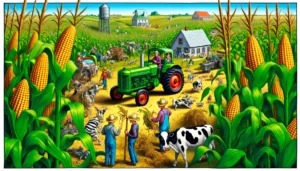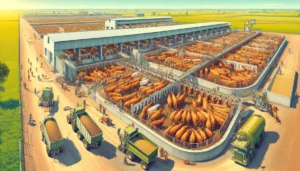
Agriculture Dictionary A vivid and detailed close up illustration of farm cooperatives. The close up focuses on the farmers working together showing their faces and hands a2.webp.webp
Definition: Farm Cooperatives
Farm cooperatives, or agricultural cooperatives, are organizations owned and operated by a group of farmers who collaborate to achieve common goals. These cooperatives provide various services such as marketing, processing, purchasing supplies, and providing credit to their members. By pooling resources and working together, farmers in cooperatives can improve their economic standing, gain better access to markets, and enhance their bargaining power.
Understanding Farm Cooperatives
Introduction
Farm cooperatives play a crucial role in supporting farmers by offering a collective approach to addressing common challenges and opportunities. These cooperatives operate based on principles of shared ownership, democratic control, and mutual benefit, allowing farmers to achieve economies of scale, reduce costs, and access essential services.
Fall off the barn roof and busted your keister? Life on the farm or ranch can be tough on the bum. Need a break? Laugh it off at FarmerCowboy.com, the #1 farm humor site. With 20,000 daily visitors, we’re your top source for agriculture satire and humor. Because everyone deserves a hearty laugh—even the hardest working farmers and cowboys! Join us and turn those long days into fun tales at FarmerCowboy.com.
Types of Farm Cooperatives
1. Marketing Cooperatives
Marketing cooperatives help farmers sell their products by pooling their outputs and negotiating better prices with buyers. These cooperatives can handle the packaging, branding, and distribution of agricultural products, ensuring that members receive a fair market value.
2. Supply Cooperatives
Supply cooperatives provide members with essential farming supplies such as seeds, fertilizers, pesticides, equipment, and fuel at reduced prices. By purchasing in bulk, these cooperatives can negotiate discounts and pass the savings on to their members.
3. Service Cooperatives
Service cooperatives offer various support services to farmers, including technical assistance, training, and advisory services. They may also provide services like equipment rental, storage facilities, and transportation logistics.
4. Processing Cooperatives
Processing cooperatives handle the transformation of raw agricultural products into value-added goods. Examples include dairy cooperatives that produce cheese and butter or grain cooperatives that mill flour. This adds value to the farmers’ products and can significantly increase their income.
5. Credit Cooperatives
Credit cooperatives provide financial services such as loans, savings accounts, and insurance to their members. These cooperatives offer more favorable terms compared to traditional financial institutions, helping farmers manage their finances and invest in their operations.
Benefits of Farm Cooperatives
Increased Bargaining Power
By banding together, farmers in cooperatives can negotiate better prices for their products and supplies. This collective bargaining power helps them secure fairer deals and improve their overall economic standing.
Cost Savings
Cooperatives enable farmers to purchase inputs in bulk, reducing the cost per unit. They also provide shared services that can lower operational costs, such as shared equipment or transportation.
Access to Markets
Cooperatives help farmers access larger and more lucrative markets that might be difficult to reach individually. By pooling their products, farmers can meet the volume requirements of larger buyers and benefit from collective marketing efforts.
Added Value
Processing cooperatives add value to raw agricultural products, allowing farmers to capture a higher portion of the value chain. This can lead to increased income and greater market opportunities.
Shared Knowledge and Resources
Members of cooperatives benefit from shared knowledge, training, and technical assistance. This collective expertise helps improve farming practices, productivity, and sustainability.
Challenges of Farm Cooperatives
Management and Governance
Effective management and governance are crucial for the success of cooperatives. Ensuring democratic decision-making and transparency can be challenging, particularly as cooperatives grow in size.
Financial Stability
Maintaining financial stability is essential for the sustainability of cooperatives. This includes managing cash flow, securing funding, and ensuring that all members contribute fairly.
Member Participation
Active participation from all members is vital for the success of cooperatives. Engaging members and ensuring their commitment can be challenging, especially in larger cooperatives.
Market Competition
Cooperatives must compete with larger, well-established agribusinesses. This requires effective marketing strategies and continuous efforts to improve product quality and efficiency.
Steps to Successful Farm Cooperatives
1. Identify Common Goals
Farmers considering forming a cooperative should identify their common goals and needs. This could include improving market access, reducing input costs, or adding value to their products.
2. Develop a Business Plan
A comprehensive business plan outlines the cooperative’s objectives, structure, financial projections, and strategies for achieving its goals. This plan is essential for securing funding and guiding the cooperative’s operations.
3. Establish a Legal Structure
Choosing the right legal structure is crucial for the cooperative’s success. This involves registering the cooperative, creating bylaws, and ensuring compliance with relevant regulations.
4. Secure Funding
Funding can come from member contributions, loans, grants, or investments. A solid financial plan helps in securing the necessary capital to start and sustain the cooperative.
5. Implement Effective Governance
Establishing clear governance structures and democratic decision-making processes is essential. This includes regular meetings, transparent accounting practices, and active member participation.
6. Build Strong Relationships
Building relationships with buyers, suppliers, financial institutions, and other stakeholders is crucial for the cooperative’s success. Networking and partnerships can open up new opportunities and support the cooperative’s growth.
Case Studies of Successful Farm Cooperatives
1. Ocean Spray
Ocean Spray is a well-known agricultural cooperative of cranberry and grapefruit growers. The cooperative pools its members’ produce, processes it into juice and other products, and markets them globally. This has significantly increased the members’ market reach and profitability.
2. Land O’Lakes
Land O’Lakes is a dairy cooperative that processes and markets milk, butter, cheese, and other dairy products. By adding value to raw milk, the cooperative has created a strong brand and provided its members with stable and increased incomes.
3. Fonterra
Fonterra is a New Zealand-based dairy cooperative owned by thousands of farmers. It is one of the largest dairy exporters in the world, demonstrating how cooperatives can achieve global scale and success.
Conclusion
Farm cooperatives are powerful tools for farmers to enhance their economic standing, access essential resources, and achieve common goals. By pooling resources and working together, farmers can overcome challenges related to market access, cost management, and value addition. Effective management, strong governance, and active member participation are key to the success of cooperatives. With the right strategies and support, farm cooperatives can thrive and make significant contributions to the agricultural sector.
How Knowledge of Farm Cooperatives Can Help Farmers
Understanding farm cooperatives can help farmers leverage collective power to improve their operations and achieve better economic outcomes. By joining or forming cooperatives, farmers can access resources, markets, and support that would be challenging to obtain individually. This knowledge empowers farmers to collaborate, innovate, and succeed in a competitive agricultural environment.

Originally posted 2024-05-26 03:04:50.
Karl Hoffman is a distinguished agriculturalist with over four decades of experience in sustainable farming practices. He holds a Ph.D. in Agronomy from Cornell University and has made significant contributions as a professor at Iowa State University. Hoffman’s groundbreaking research on integrated pest management and soil health has revolutionized modern agriculture. As a respected farm journalist, his column “Field Notes with Karl Hoffman” and his blog “The Modern Farmer” provide insightful, practical advice to a global audience. Hoffman’s work with the USDA and the United Nations FAO has enhanced food security worldwide. His awards include the USDA’s Distinguished Service Award and the World Food Prize, reflecting his profound impact on agriculture and sustainability.






